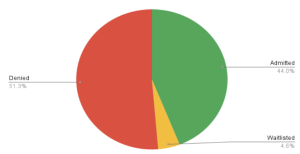The consequence of the “Freshman Fifteen” meal plan
April 18, 2019
I’m a freshman at Union and like you I tend to eat food every day. Similar to most other athletes and young men and women under the age of 25, my diet also tends to exceed the typified 2,000 calories a day, which is recommended by most nutritionists.
At one point during last summer, while I was weight training (an activity in which many Union College men and women partake), I was instructed to eat a caloric surplus in order to put on muscle mass. This meant eating at least 2,500 calories a day and sometimes upwards of 3,000. However, these are baby numbers compared to what a linebacker needs to eat in a given day, who would frequently try to exceed 3,000 calories daily.
Still, I understand that most of us are not gigantic linebackers that need crazy amounts of food. Most of us at this school are just trying to stay in shape and eat enough to maintain a healthy diet. So let’s stick with the 2,000 calorie recommendation given by the FDA. Eating that much food can be obtained in several different ways, the most common and standard method being the good ol’ three meals a day: breakfast, lunch and dinner.
While not everyone eats three meals a day every day, it is considerably healthier spread out your calorie intake over at least three intervals. However, even with most people needing to eat three meals of around 600-700 calories daily, the problem with the “freshman fifteen” meal plan is that it simply does not provide students with enough declining or meal swipes to consistently reach the three meal benchmark.
The freshman 15 provides students with 15 meal swipes a week and $250 of declining every term. That means that if we’re eating three meals a day, we need to use our declining for six meals every week. The average cost of a meal at Reamer, if we’re being conservative, is about seven dollars. That means we’re spending a total of $42 of declining a week to supplement the meals not provided for by meal swipes in the freshman fifteen. Over the course of one ten-week term, a student who is just trying to eat three meals a day everyday needs $420 of declining in their account, which is way less than the $250 provided by the plan.
The argument behind the lack of declining is that most students skip breakfast on Saturdays and Sundays, meaning that they only need to supplement four meals a week with declining instead of six. While many students do skip breakfast on weekends, this plan assumes that the average cost of a meal at Reamer is $6.25, which isn’t true unless you’re strictly buying basic one egg wraps with no meat, hash browns, or drink every meal you spend there.
Creating a meal plan that encourages unhealthy eating habits is also a flaw in and of itself. No student should be given a meal plan that only allows you to eat 19 meals a week, even if that is conceived as the norm. Colleges should aspire to create meal plans that would enable nutritiously conscious students to eat the bare minimum of what is considered to be a healthy diet, and not force young men and women to skip breakfasts on the weekends as an alternative.
The meal plan hits especially hard on athletes who need every calorie they can get to stay fit and ready to perform at peak performance. Most weight lifters and football players will tell you that it’s much easier to hit a 2,500 plus calorie diet while eating four meals daily, a feat that is practically impossible under the freshman 15. To provide themselves with enough food to eat up to standards with other athletes, students must dip well into their pocket every term to pay for meals with their own money.
There are several ways to solve the problem of the freshman 15, some more economical than others. The simplest way to solve the problem is to give freshman 15 meal swipes and $450 of declining. That would be enough to adequately supplement our diets with three meals a day.
Another option would be to increase the number of meal swipes to 17 per week, which would most likely be more comfortable for the school to do considering the economic benefits received when students pay for their meals with declining.
Another simple option would be to allow students the opportunity to take meals from the dining halls back to their dorms in take-home boxes. This would require no increase in meal swipes and would let the students who are nutritiously conscious reach their caloric goals. While it would cost more money than any option so far, a separate meal plan needs to be created for the third of students who are athletes at this school, as their caloric needs are much higher than the regular student body.
All of the possible solutions to the freshman 15 cost money and would require the school to make decisions with their budget, but in my opinion, the nutrition of students needs to be held at the utmost importance. Proper nutrition affects mood, stress levels, physical health and can have a direct effect on performance in the classroom or in the field of play. I hope that one day the school can provide access for students to consistently reach three meals a day every day they live at Union College.








